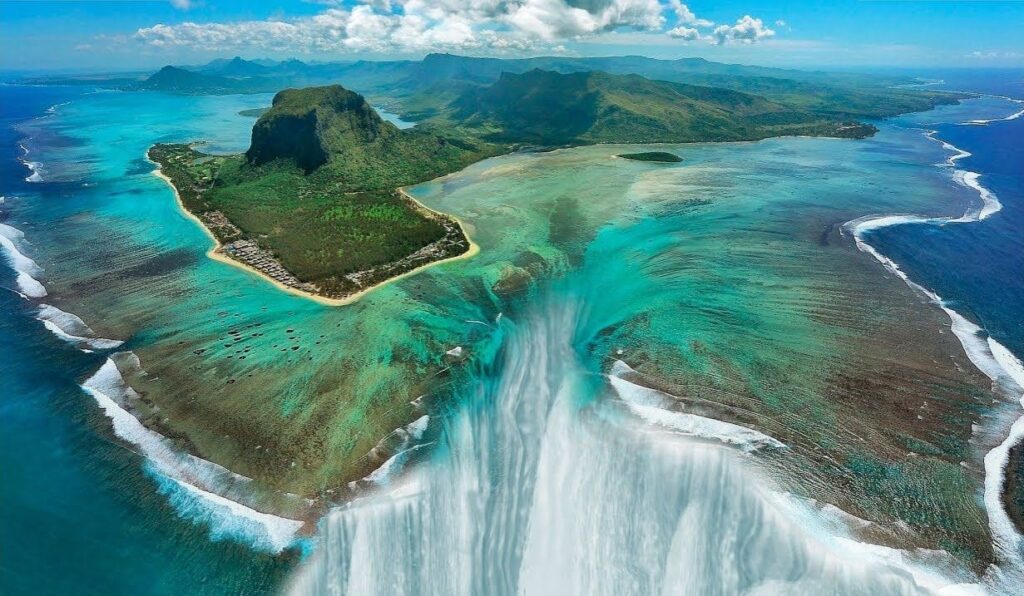PLUNGING INTO THE ABYSS: EXPLORING EARTH’S HIDDEN GIANT – THE DENMARK STRAIT CATARACT
Concealed in the stormy North Atlantic lies Earth’s greatest waterfall, an underwater giant hidden from view in the darkness between Iceland and Greenland. Here, where warm subtropical waters collide with a frigid Arctic cataract, the largest waterfall on the planet plunges silently into the abyss.
Over 11,500 feet in height and more than 160 kilometers wide, the Denmark Strait Cataract is a behemoth by any measure. This marine monster thunders unseen down a two-mile underwater cliff, making iconic waterfalls like Angel Falls seem Lilliputian in comparison.
Oceanographers mapped this colossal phenomenon only recently through remote sensing, unveiling a breathtaking marvel invisible from the surface. What forces shape this submarine spectacle that dwarfs all other waterfalls? And what mysteries may yet lurk in Earth’s unseen places?

WHERE FIRE MEETS ICE
The North Atlantic is a tempestuous realm ruled by titanic currents and climate forces. The area surrounding Iceland forms a pivotal marine crossroads where warm subtropical waters collide with frigid Arctic overflow. The Denmark Strait itself is a boundary. Its where the Irminger Current’s relatively mild flow meets the frozen avalanche of the East Greenland Current.
It is here that conditions ripen for the Denmark Strait Cataract’s conception. Icy waters sinking from Greenland’s glaciers become colder and denser than the Irminger Current’s warmer yet lighter touch. At this clash zone along the Mid-Atlantic Ridge, heavier polar waters plunge furiously beneath subtropical currents. They’re sucked down by gravity’s pull into the abyssal trench splitting Iceland and Greenland.
A TWO-MILE MONSTER REVEALED
As polar waters cascade into the void, they create an epic waterfall by any measure. Measuring over 160 kilometers wide, the curtain of water and spray hides completely 3,300 meters down. This is far beyond where sunlight penetrates. At highest estimates, 175 million cubic meters of seawater thunder over the cataract’s brink each second – a discharge dwarfing even the Amazon River.
In fact, almost nothing natural compares to the Denmark Strait Cataract’s enormity. At over 11,500 feet from top to bottom, it stands much taller than world champion Angel Falls in Venezuela, which seems Lilliputian at just 3,200 feet. South America’s roaring Iguazu Falls astounds tourists with its 1.7 mile wide torrent. It covers less than a tenth the width spanned by the submerged cataract’s 100-mile broad cascade.
By any metric – height, flow or breadth – the cyclopean Denmark Strait Cataract conquers all rivals to rank as Earth’s largest waterfall. Yet owing to its clandestine marine setting, no human eyes have ever glimpsed this hidden giant.

For surface-dwelling souls, the submarine realm conceals countless wonders beyond reach or sight. But through advanced monitoring technology, oceanographers are charting what lies beneath. Sensor data reveals hidden habitats, undiscovered species and geological marvels hidden for eons in the impenetrable depths.
The Mighty Strait Cataract
The mighty Denmark Strait Cataract remained similarly concealed until modern science illuminated it. Once charted, the cataract’s contours and dynamics came into focus, yet its immensity was breathtaking. We now know Arctic waters power the falls, but many mysteries around its workings await. And who knows what secrets else course through the silent darkness in Earth’s hidden places?
Much remains enigmatic about this marine mammoth. But clearly an epic tale underpins the mythical tears said to have carved this colossal cataract. Where science leaves uncertainty, imagination readily conjures epic histories. What ancient cataclysm or broken magic wrought this weeping wound in the ocean bed? However it came to be, the soundless symphony of the Denmark Strait Cataract sings an old soul’s song…one we strain yet struggle to hear.

📈😲Additional Facts
123 Million
cubic feet per second. This is the estimated volume of downward flow at the Denmark Strait.



